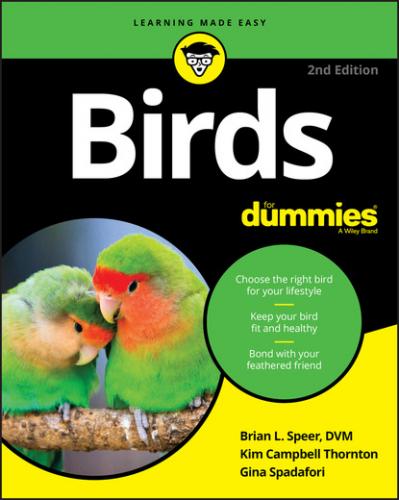PET BIRDS AND CHILDREN
Birds can be wonderful companions for children, but sometimes the reverse isn’t so true. Children who are too young or unable to understand the importance of gentle, respectful handling can end up with a dead bird pretty quickly — truly a tragedy for all involved.
The look-don’t-touch birds such as canaries and other finches are best for very young children. From the age of 8 or so, a child can begin to understand instructions for correctly handling smaller parrots, making budgies and cockatiels a good match for these older children. When kids enter their teens, almost any bird who fits the family’s lifestyle can be a good match.
In Brian’s experience, children who learn to communicate nonverbally with a bird in a constructive, mutual way often have a great learning experience that stands them in good stead later in life, both with humans and with other animals. Birds can really help to teach us how to be better people, as well as better communicators with other humans and with birds.
Remember, though, that taking proper care of any pet is the parent’s responsibility. Lead by example. Don’t make the pet the focus of a tug-of-war between you and your child. The lesson of responsibility is a good one to draw from a relationship with a pet, but so, too, are the lessons of compassion, caring, and respect for another living being.
Males are usually better at vocalizing, with whistling a specialty. Cockatiels are generally not the best talkers, but males can pick up a few words or phrases. Don’t let the lack of verbosity dissuade you, though: The gentle cockatiel is about as fine an avian companion as you can imagine.
Medium-size parrots
Pricier and less commonly available than budgies and cockatiels — and generally less flashy and colorful than their larger relatives — the medium-size parrots are often overlooked and underappreciated. And that’s a shame, because in this group you can find some wonderful companions — handsome birds who are relatively neat and quiet (with a couple of notable exceptions) and reasonably priced to acquire and care for. A great bunch!
Poicephalus
The Senegal (shown in Figure 2-5) is probably the most popular of the class of smaller African parrot species known collectively under the genus Poicephalus. The Senegal parrot is reasonably priced, at around $600 to $800 for a hand-fed baby. Senegals are neat and quiet as parrots go, and handsome in a somewhat unspectacular way — green feathers on the back, a mango-colored breast, and a gray head.
Photograph courtesy of Amy Baggs
FIGURE 2-5: Quieter and more easygoing than many other parrots, the Senegal is a good choice for first-time bird owners.
Personable and affectionate, Senegals are capable of picking up a few words and phrases, but they’re not generally known for their talking ability. Good for many living situations, small apartments included, Senegal parrots have much to offer as companion birds for many people.
The others in this group — including the red-bellied, Meyer’s, and Jardine’s parrots — are comparatively more difficult to find and notably more expensive (up to $1,200 or so) than the Senegal parrot but are well worth seeking out. The life span of a healthy, well-cared-for Poicephalus can range from 20 to 40 years.
Lories and lorikeets
You see a lot of lories and lorikeets in zoos and commercial aviaries — their fantastic good looks and clownish personalities are undeniable attractions. They’re a delight to watch, a rainbow of intense, vibrant color. The lory feeding exhibits in many zoos and wildlife parks are popular draws for thousands of people worldwide.
If you can overlook the mess — and many people cope just fine — lories are lovely pets. The spectacular rainbow lory, in particular, is a good choice in this group, goofy and fun to be around. Lories aren’t suited for close-quartered living, however, because of some decidedly high-decibel noise. Prices of lories are moderate: $400 and up, depending on the species.
The difference between lories and lorikeets is generally the length of their tails. Lorikeets, like parakeets, have longer tail feathers. If you get a chance to meet some of these birds in person, you’re in for an olfactory experience you won’t believe! The feathers of lories and lorikeets smell absolutely fabulous, perhaps because of their fruit-centric diet. Other bird species have their own unique odors, but these guys take the deliciously scented cake!
Conures
The rap on conures is that they should be sold along with earplugs for everyone around them — neighbors very much included. Some conures well deserve this reputation for noisiness — those vociferous sorts may be more closely related to macaws — but not all conures can be credited with a noisy nature.
We include conures with the medium-size parrots because some of the most common ones, such as the sun conure, aren’t all that large. As a group, though, conures display a wide range of size, with species such as the mitred really qualifying as a large parrot.
The conures of the Aratinga genus are usually the real noisemakers — the sun, jenday, golden-capped, mitred, red-fronted, dusky, and white-eyed, to name a few. Although not of the Aratinga genus, the nanday and the Patagonian conures are other conures with a well-earned reputation for noise.
Aratinga conures have formidable vocal abilities when it comes to shrieking and frequently have little hesitation to share their talents. Of these, the sun conure is probably the most attractive, enticing people to figure they can live with the noise just to enjoy the beauty and antics of these clever parrots.
